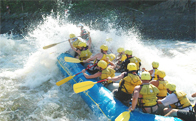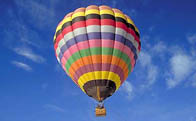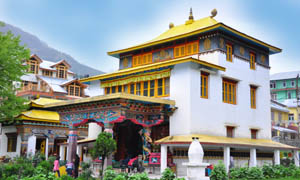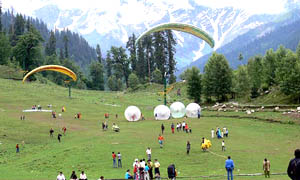Things you can enjoy with Camp Exotica
 |
Rafting or Whitewater Rafting Is a challenging recreational activity using an inflatable raft to navigate a river or other bodies of water. This is usually done on whitewater or different degrees of rough water, in order to thrill and excite the raft passengers |  |
Paragliding It is a recreational flying sport. A paraglider is a free-flying, foot-launched aircraft. The pilot sits in a harness suspended below a fabric wing, whose shape is formed by its suspension lines and the pressure of air entering vents in the front of the wing. |
|
 |
Zorbing The activity of zorbing is the recreational practice of humans rolling downhill in a sphere, generally made of transparent plastic. Sphereing is generally performed on a gentle slope, but can also be done on a level surface |
 |
Rock climbing Rock climbing is a sport in which participants climb up or across natural rock formations or man-made rock walls. The goal is to reach the summit of a formation or the endpoint of a pre-defined route. Use of hands to support the climber's weight as well as to provide balance. |
|
 |
Trekking It tends to be less-structured than other sort of travel, as weather conditions and topography help influence travel plans. Travelers move on foot through often-rural areas, trekking gives travelers an up-close view of incredible scenery |
 |
Cycling You must be a very good biker, the high passes are not technical unpretending. The road is to 80% paved and the distances are not too long. A support car carries your luggage, so you can enjoy the great Himalayan range at the best views. |
|
 |
Snow scooters A very popular leisure vehicle when people want small or long ride. After taking ride of snowboard, one can find himself in a magnificent nature filled with experiences and adventures. You may either drive snow scooter with an experienced snow scooter driver or drive yourself together with a guide |
 |
Skiing in Manali Is considered as one of the best activities for adventure sports on tours to Manali. A visit to this beautiful hill town of Himachal Pradesh offers fabulous opportunity for skiing, heli skiing, snow boarding, ice skating, and other ice sports. These activities can be enjoyed not only by professionals but also for beginners. |
|
 |
Hot Air Ballooning In Manali Is latest trend that's gaining interest between visitors, specially newly weds and kids. Riding up above in air suddenly lifts the energy levels to excitement and makes a perfect adventure sport in Manali. Hot air balloons in Manali are organised safely near wide open spaces. |
 |
Fishing in Manali There are several sites along River Beas and its tributaries that have plentiful trout fish. These are Kalath, Katrain, Raison and Seobagh. The 35 km long stretch along River Parbati is known for its fantastic size of trout. Larji to Ropa in Sainj Nullah are idyllic trout fishing sites. River Tirthan offers you trout angling at numerous spots. |

















